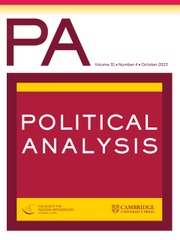Crossref Citations
This article has been cited by the following publications. This list is generated based on data provided by
Crossref.
Norris, Pippa
Martinez i Coma, Ferran
and
Grrmping, Max
2016.
The Electoral Integrity Project: The Year in Elections, 2015.
SSRN Electronic Journal,
Rozenas, Arturas
2017.
Detecting Election Fraud from Irregularities in Vote-Share Distributions.
SSRN Electronic Journal,
Rozenas, Arturas
2017.
Detecting Election Fraud from Irregularities in Vote-Share Distributions.
Political Analysis,
Vol. 25,
Issue. 1,
p.
41.
Gilbreath, Dustin
and
Balasanyan, Sona
2017.
Elections and election fraud in Georgia and Armenia.
Caucasus Survey,
Vol. 5,
Issue. 3,
p.
238.
Montgomery, Jacob M.
and
Olivella, Santiago
2018.
Tree‐Based Models for Political Science Data.
American Journal of Political Science,
Vol. 62,
Issue. 3,
p.
729.
Poulos, Jason
and
Valle, Rafael
2018.
Missing Data Imputation for Supervised Learning.
Applied Artificial Intelligence,
Vol. 32,
Issue. 2,
p.
186.
CANTÚ, FRANCISCO
2019.
The Fingerprints of Fraud: Evidence from Mexico’s 1988 Presidential Election.
American Political Science Review,
Vol. 113,
Issue. 3,
p.
710.
Mack, Verena
and
Stoetzer, Lukas F.
2019.
Election fraud, digit tests and how humans fabricate vote counts - An experimental approach.
Electoral Studies,
Vol. 58,
Issue. ,
p.
31.
Zhang, Mali
Alvarez, R. Michael
Levin, Ines
and
Ribeiro, Haroldo V.
2019.
Election forensics: Using machine learning and synthetic data for possible election anomaly detection.
PLOS ONE,
Vol. 14,
Issue. 10,
p.
e0223950.
Kim, Seo‐young Silvia
Alvarez, R. Michael
and
Ramirez, Christina M.
2020.
Who Voted in 2016? Using Fuzzy Forests to Understand Voter Turnout.
Social Science Quarterly,
Vol. 101,
Issue. 2,
p.
978.
Cui, Yanjun
and
Wang, Junhu
2020.
Data Science.
Vol. 1179,
Issue. ,
p.
538.
GOEL, SHARAD
MEREDITH, MARC
MORSE, MICHAEL
ROTHSCHILD, DAVID
and
SHIRANI-MEHR, HOUSHMAND
2020.
One Person, One Vote: Estimating the Prevalence of Double Voting in U.S. Presidential Elections.
American Political Science Review,
Vol. 114,
Issue. 2,
p.
456.
Alvarez, R. Michael
Adams-Cohen, Nicholas
Kim, Seo-young Silvia
and
Li, Yimeng
2020.
Securing American Elections.
Funk, Kendall D.
Paul, Hannah L.
and
Philips, Andrew Q.
2022.
Point break: using machine learning to uncover a critical mass in women's representation.
Political Science Research and Methods,
Vol. 10,
Issue. 2,
p.
372.
Klimek, Peter
Aykaç, Ahmet
Thurner, Stefan
and
Mahmoud, Ali B.
2023.
Forensic analysis of the Turkey 2023 presidential election reveals extreme vote swings in remote areas.
PLOS ONE,
Vol. 18,
Issue. 11,
p.
e0293239.
Koenig, Christoph
2024.
With a Little Help From the Crowd: Estimating Election Fraud with Forensic Methods.
SSRN Electronic Journal,
Anwar, Nahid
Jain, Amit
and
Kettler, Jaclyn J.
2025.
Forensic Techniques for Detecting Election Fraud (2024 ESRA Issue).
Election Law Journal: Rules, Politics, and Policy,
Ahlbäck, Johan
and
Jablonski, Ryan
2025.
How to Distinguish Human Error From Election Fraud: Evidence From the 2019 Malawi Election.
British Journal of Political Science,
Vol. 55,
Issue. ,
Koenig, Christoph
2025.
With a little help from the crowd: Estimating election fraud with forensic methods.
Electoral Studies,
Vol. 96,
Issue. ,
p.
102943.
Brochier, Christophe
2025.
Détecter statistiquement des résultats électoraux « anormaux » au niveau local ?.
Bulletin of Sociological Methodology/Bulletin de Méthodologie Sociologique,
Vol. 168,
Issue. 1,
p.
36.

